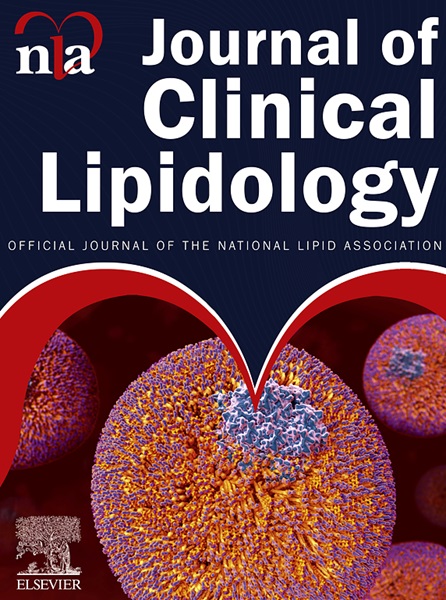Serum mature and furin-cleaved proprotein convertase subtilisin/kexin type 9 levels and their association with cardiovascular events in statin-treated patients with cardiovascular disease
IF 4.6
3区 医学
Q2 PHARMACOLOGY & PHARMACY
引用次数: 0
Abstract
BACKGROUND AND AIMS
Previous studies have not found a consistent association between circulating proprotein convertase subtilisin/kexin type 9 (PCSK9) levels and the risk of cardiovascular events partly due to measurement methods that cannot distinguish between uncleaved and furin-cleaved forms of PCSK9.
METHODS
This is a prespecified sub-study of the REAL-CAD study which is a prospective, multicenter, randomized trial to compare high- versus low-dose statin in patients with stable coronary artery disease (CAD). The primary endpoint was major adverse cerebrovascular and cardiovascular events (MACCE) defined as a composite of cardiovascular death, nonfatal myocardial infarction, nonfatal ischemic stroke, or unstable angina requiring emergency hospitalization. In this case-cohort study, serum mature (uncleaved) and furin-cleaved PCSK9 levels obtained at 6 months after randomization were measured among 426 participants who developed MACCE (cases) and 1,478 randomly selected participants (sub-cohort).
RESULTS
From 1,478 patients in the sub-cohort, the Cox proportional hazards models with a pseudolikelihood method for case-cohort design revealed that the risk of the primary endpoint in patients with the highest quartile of mature PCSK9 levels was similar to that in the lowest quartile (hazard ratio [HR] 0.809; 95% confidence intervals [CI], 0.541-1.209). Similarly, the HR for the highest to lowest quartiles of furin-cleaved PCSK9 was 0.948 (95% CI, 0.645-1.392) (P = 0.784). Compared to the lowest quartile, neither serum mature nor furin-cleaved PCSK9 levels predicted MACCE.
CONCLUSIONS
In a large-scale secondary prevention cohort, serum mature and furin-cleaved PCSK9 levels did not provide useful information for predicting future cardiovascular events in statin-treated patients with stable CAD.
他汀类药物治疗的心血管疾病患者的血清成熟和呋喃裂解蛋白酶枯草酶/kexin 9 型水平及其与心血管事件的关系
背景和目的以往的研究并未发现循环中的9型亚铁基转录酶/kexin(PCSK9)水平与心血管事件风险之间存在一致的联系,部分原因是测量方法无法区分PCSK9的未分化形式和呋喃裂解形式。该研究是一项前瞻性、多中心、随机试验,旨在比较稳定型冠状动脉疾病(CAD)患者服用高剂量他汀与低剂量他汀的效果。主要终点是主要脑血管和心血管不良事件(MACCE),定义为心血管死亡、非致死性心肌梗死、非致死性缺血性中风或需要紧急住院治疗的不稳定型心绞痛的综合。在这项病例队列研究中,对 426 名发生 MACCE 的参与者(病例)和 1,478 名随机抽取的参与者(子队列)进行了随机分组后 6 个月的血清成熟(未分化)和呋喃分化 PCSK9 水平测定。结果从子队列中的1,478名患者中,采用病例队列设计的伪似然法建立的Cox比例危险模型显示,成熟PCSK9水平最高四分位数患者的主要终点风险与最低四分位数患者相似(危险比[HR]0.809;95%置信区间[CI],0.541-1.209)。同样,呋喃裂解 PCSK9 的最高四分位数到最低四分位数的危险比为 0.948(95% CI,0.645-1.392)(P = 0.784)。与最低四分位数相比,血清成熟PCSK9和呋喃裂解PCSK9水平均不能预测MACCE。结论在大规模二级预防队列中,血清成熟PCSK9和呋喃裂解PCSK9水平不能为预测他汀治疗的稳定型CAD患者未来的心血管事件提供有用信息。
本文章由计算机程序翻译,如有差异,请以英文原文为准。
求助全文
约1分钟内获得全文
求助全文
来源期刊
CiteScore
7.00
自引率
6.80%
发文量
209
审稿时长
49 days
期刊介绍:
Because the scope of clinical lipidology is broad, the topics addressed by the Journal are equally diverse. Typical articles explore lipidology as it is practiced in the treatment setting, recent developments in pharmacological research, reports of treatment and trials, case studies, the impact of lifestyle modification, and similar academic material of interest to the practitioner.
Sections of Journal of clinical lipidology will address pioneering studies and the clinicians who conduct them, case studies, ethical standards and conduct, professional guidance such as ATP and NCEP, editorial commentary, letters from readers, National Lipid Association (NLA) news and upcoming event information, as well as abstracts from the NLA annual scientific sessions and the scientific forums held by its chapters, when appropriate.

 求助内容:
求助内容: 应助结果提醒方式:
应助结果提醒方式:


